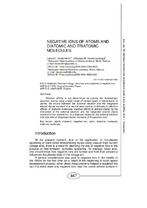| dc.contributor.author | Gretchikhin, L. I. | en |
| dc.contributor.author | Kamarouskaya, V. M. | en |
| dc.date.accessioned | 2020-11-03T07:07:56Z | |
| dc.date.available | 2020-11-03T07:07:56Z | |
| dc.date.issued | 2016 | ru |
| dc.identifier.citation | Gretchikhin, L. I. Negative ions of atoms and diatomic and triatomic molecules = Отрицательные ионы атомов, двухатомных и трехатомных молекул / L. I. Gretchikhin, V. M. Kamarouskaya // Vojnotehnicki glasnik. – 2016. – Vol. 64, № 2. – P. 447-464. | en |
| dc.identifier.uri | https://rep.bntu.by/handle/data/81130 | en |
| dc.description.abstract | Electron affinity is not determined by solving the Schrödinger equation, but by using a wide range of various types of interactions. In atoms, the bound between the external electron and the integrated electric dipole moment of a neutral atom mainly contributes to electron affinity. In diatomic molecules, electron affinity is defined mainly by the interaction of the external electron and the integrated electric dipole moment of the nearest ion. In a triatomic molecule, the external electron interacts with all integrated dipole moments of the positive core. | en |
| dc.language.iso | en_US | en |
| dc.title | Negative ions of atoms and diatomic and triatomic molecules | en |
| dc.title.alternative | Отрицательные ионы атомов, двухатомных и трехатомных молекул | ru |
| dc.type | Article | ru |
| local.description.annotation | Сродство к электрону не определяется путем решения уравнения Шредингера, а определяется большой совокупностью разных типов взаимодействий. В атомах основной вклад в сродство к электрону вносит связь между внешним электроном и встроенным дипольным электрическим моментом нейтрального атома. В двухатомных молекулах энергию сродства преимущественно определяет взаимодействие внешнего электрона со встроенным дипольным электрическим моментом ближайшего иона. В трехатомной молекуле внешний электрон взаимодействует со всеми встроенными дипольными моментами положительного остова. | ru |

